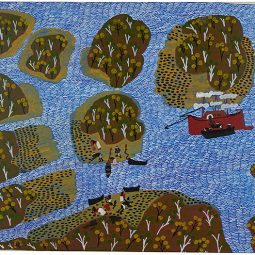Structure, division, repetition and algorithms help us to navigate the everyday, organise ourselves, are key to appreciating the rhythms and patterns of the natural world and, as Rosalind Krauss argued in her seminal essay ‘Grid’ (1985) represent modernity in Western art history. With such conceptual and aesthetic meaning in mind Al Munro’s practice and curatorial interest has developed as have her contemporaries, artists Emma Beer, Sally Blake, Julie Brooke, Kirsten Farrell, Jay Kochel and Wendy Teakel all on show in ‘Off Grid’.

Jay Kochel, Karesansui 1, 2016, machine drawing, pen on chalkboard paint on 300gsm Snowden, 15 panels, AP edition of 3, 47 x 52.5cm each. Courtesy the artists and MAY SPACE, Sydney
Munro is interested in the notion that the grid, which we think of as ‘static’, presents an opportunity for freedom, as she shared, ‘a textile grid may allow for a movement ‘through’ its gridded form as well as for a capturing within the grid – a fishing net allows for water and small fish to pass through its mesh as much as it catches larger fish within.’ Grids are considered in this more inclusive way by historian Hannah Higgins, who asserts that grids should not be seen purely as systems of parallel lines, constraint and control. Rather she contends that grids should be seen as sites of intersection, “of making and unmaking, connecting to other grids and disconnecting from them.”
What was the inspiration for this exhibition?
I was interested in putting together a number of ways to rethink the grid in terms of an elastic framework rather than a rigid controlling one. This comes as much from my interest in mathematics as it does from my textiles work and over the last few years I have worked with a mathematician to explore visualising the stretchy spaces of topology which is a kind of rubber sheet geometry. These visualisations also connect to the exploration and questioning of the relationship of 2D and 3D space in abstract painting.

Al Munro, Diamond Logic 4, 2017, acrylic and Japanese paper on birch panel, 50 x 50cm. Courtesy the artists and MAY SPACE, Sydney
Who else is working in an interdisciplinary way?
Both Julie Brook and myself have worked extensively with the ANU Department of Applied Mathematics to develop ideas around the visualisation of space. Kirsten Farrell’s interest in grids is as an analogy for language and text, and has worked in linguistics and with the Stanford World Colour Survey to develop her work.
Your relationship to the grid reflects your knowledge of textiles, can you elaborate on how the mediums the other artists are working with connect them to ‘the grid’?
Wendy Teakel employs the grid as a way to represent the land and place, Emma Beer uses grid-like structures to create layers and depth within her abstract works – Emma’s grids are deconstructed and create floating layers of varying opacity that reveal or conceal space. Sally Blake uses plant dyed fabric to create mosaic like collages and uses grids as a reference to human attempts to control the environment that resists such predictability and continues to allow sublime and poetic experiences for those who engage with it.

Wendy Teakel, Microclimate II, 2016, rabbit fur, pastel on rusted corrugated iron, 183 x 258cm. Courtesy the artists and MAY SPACE, Sydney
Do you feel colourists and abstraction are cultivated well in the ACT?
Yes weirdly it seems to be the case. Curator Deborah Clark highlighted this in her exhibition a few years ago at Canberra Museum and Art Gallery called ‘Something in the Air’. I wouldn’t like to guess why it’s so, other than that shared interests can create a critical mass of practice, which develops a strength, and cohesiveness of ideas in the work.
MAY SPACE
Until 13 May, 2017
Sydney


